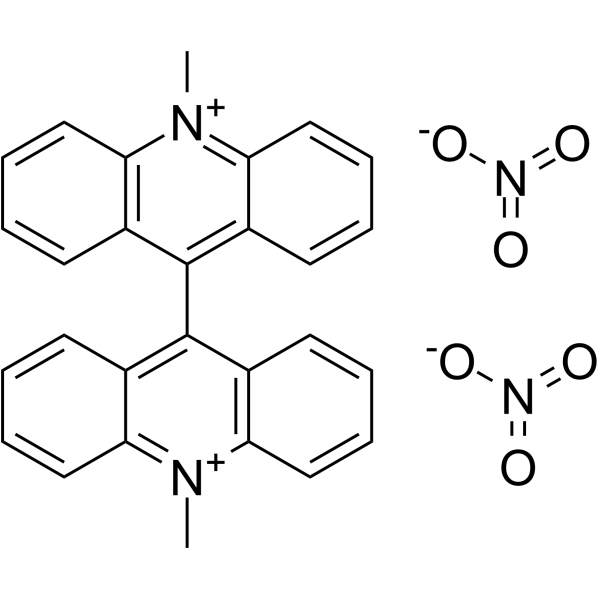
Lucigenin(L-6868; NSC-151912) is a chemiluminescent probe used to indicate the presence of endogenously generated superoxide anion radicals in cells. Upon single-electron reduction of Lucigenin by a radical species the subsequent form of Lucigenin presents an amplified chemiluminescence which is measurable and can be correlated to the respective amount of reactive radical species present in the system. This approach can be used to probe the natural generation of these species as well as the natural functioning of superoxide dismutase and other enzymes responsible for scavenging radicals. In addition to indicating the presence of radicals in cells, Lucigenin shows interaction with redox-active oxidoreductase enzymes. Lucigenin is shown to mediate the reduction of cytochrome C by xanthine oxidase and to increase the rate of NADPH oxidation. These observations indicate that use of Lucigenin for superoxide analysis is precluded in the presence of high levels of NAD(P)H-oxidoreductases.
| Molecular Weight | 510.5 |
| CAS Number | 2315-97-1 |
| Solubility (25°C) | DMSO 62.5 mg/mL |
| Storage | 2-8°C, protect from light, dry, sealed |
| Species | Mouse | Rat | Rabbit | Guinea pig | Hamster | Dog |
| Weight (kg) | 0.02 | 0.15 | 1.8 | 0.4 | 0.08 | 10 |
| Body Surface Area (m2) | 0.007 | 0.025 | 0.15 | 0.05 | 0.02 | 0.5 |
| Km factor | 3 | 6 | 12 | 8 | 5 | 20 |
| Animal A (mg/kg) = Animal B (mg/kg) multiplied by | Animal B Km |
| Animal A Km |
For example, to modify the dose of Compound A used for a mouse (20 mg/kg) to a dose based on the BSA for a rat, multiply 20 mg/kg by the Km factor for a mouse and then divide by the Km factor for a rat. This calculation results in a rat equivalent dose for Compound A of 10 mg/kg.
| Related Fluorescent Dye Products |
|---|
| SOSG
SOSG (Singlet Oxygen Sensor Green Fluorescent Probe) is highly selective for singlet oxygen (1O2). It is commonly used for the detection of singlet oxygen in solutions and the evaluation of the efficacy of free radical scavengers. |
| FM1-43
FM1-43 is a very lipophilic, water-soluble styrene dyes, can specifically bind to cell membranes and inner membrane organelles to produce fluorescence. FM1-43 is widely used in endocytic and exospic membrane structure markers. |
| BCIP
BCIP is a chromogenic substrate for colorimetric assay of alkaline phosphatase activity. |
| MCA-SEVNLDAEFR-K(Dnp)-RR, amide
MCA-SEVNLDAEFR-K(Dnp)-RR, amide is a FRET-based substrate. |
| MeOSuc-AAPV-AMC
MeOSuc-AAPV-AMC is a fluorogenic substrate for human leukocyte and porcine pancreatic elastase (Km: 362 μM, Ex=380 nm, Em=460 nm). |


Products are for research use only. Not for human use. We do not sell to patients.
© Copyright 2010-2023 AbMole BioScience. All Rights Reserved.
